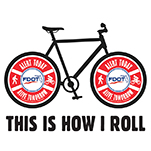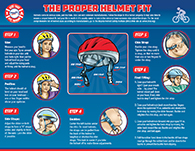Bicycle Safety

- Bicycles provide transportation, recreation, and exercise.
- For a full list of bicycle facilities, visit www.traillink.com/state/fl-trails/
- There are many health benefits to bicycling. Riding regularly can increase cardiovascular fitness, improve joint mobility, and decrease stress.
- Statewide, over half of traffic crashes resulting in serious or fatal injuries to pedestrians occur during dark or dusk hours.
- When driving, stay alert and watch for pedestrians and bicyclists especially at night.
- When riding at night, always use a headlight, taillight, and reflectors.
- Wearing light-colored or reflective clothing can also make you more visible during dark or dusk hours and is a proactive way to create high visibility.
- Whether you walk, bike, or drive, it is never safe to add drugs or alcohol to the mix. Depending on the level of impairment, you may not have the perceptual, cognitive, or physical skills required to navigate your route safely.
- Take a stand! Be personally responsible by having a plan to get home safely BEFORE taking part in activities where drugs or alcohol may be a factor.
- If you are too impaired to drive, you may be too impaired to ride a bike. Call a sober friend or use a ride share service to make sure you can get home safely.
- Even though bicycles are legally defined as vehicles in Florida, they don’t have the protection that an automobile provides. They don’t have seatbelts or airbags to help reduce the impact of a crash. They are some of our most vulnerable road users.
- Always give bicyclists plenty of space when passing. Florida law requires a 3’ minimum passing distance.
- Bicycles are harder to see than larger vehicles. Always stay alert and watch for them.
- Properly fitting your helmet and driving defensively and predictably can significantly reduce the severity of a head injury in the event of a crash.
- Any helmet involved in a crash, or impact, must be thrown away and replaced.
- The center buckle under your chin should be secure and snug so that no more than two fingers fit between your chin and the strap.
- Check the fit! Make sure the helmet does not move when nodding or shaking your head.
- Bicycle lanes buffered by pavement markings can provide exclusive space for bicyclists and create a buffer between the bike and motor vehicle lanes.
- Treat the bike lane just like you would any other travel lane and follow the same traffic laws you would if you were driving a car.
- Using hand signals make crossing intersections safer for bicyclists.
Remember: Everyone has the expectation, and right, to arrive at their destination safely no matter what mode of transportation they use.
Additional information can be found at:
Videos
Additional Resources




